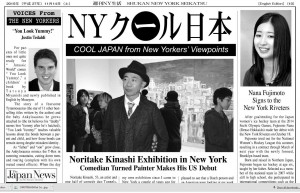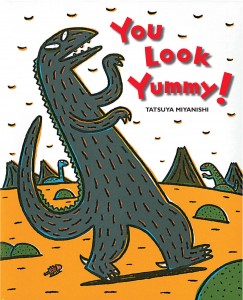JQ Magazine: Book Review — ‘Tokio Whip’

“Although Tokio Whip can be a difficult read, reading it actually resembles being in the city. You’ll learn things that are mind-blowing while wondering what exactly is going on.” (Stone Bridge Press)
By Rashaad Jorden (Yamagata-ken, 2008-10) for JQ magazine. A former head of the JETAA Philadelphia Sub-Chapter, Rashaad is a graduate of Leeds Beckett University with a master’s degree in responsible tourism management. For more on his life abroad and enthusiasm for taiko drumming, visit his blog at www.gettingpounded.wordpress.com.
Those who look fondly at their JET experience often feel that the people they met and the places they frequented greatly shaped their time in Japan. But as a lot of us—if not most of us—former JETs lived outside of the big cities, it might be interesting to read about how life in the capital might be influenced by people and places.
So Arturo Silva’s Tokyo Whip might just serve as a look at the capital that fascinates you. Silva, a native of the United States who spent the ‘80s and ‘90s in Tokyo, uses first person voice to take readers on a tour of the city experienced by Roberta and Lang, two Westerners living in the Japanese capital, and their friends. A story about life in Tokyo is probably interesting in itself. But another important story is brewing in Tokio Whip: Lang is a film director and he has created a 144-minute work divided into six scenes whose settlings include locations such as the Rikugien Garden, Seibu Ikebukuro Department Store, and Shinjuku Station—all of those being places you might be familiar with.
Most of Tokio Whip takes place in the heart of the city as Silva aims to create a novel similar to a tour of Tokyo people might go on. Even if the book really isn’t a circular tour of Tokyo, reading Tokio Whip will surely bring about some natsukashii moments or thoughts, such as one character who spent twenty minutes in Shinjuku Station looking for an exit or another character still getting lost in Shibuya Station despite being there hundreds of times.
JQ Magazine: Book Review — ‘Diary of a Tokyo Teen’
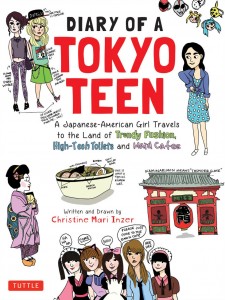
“Through reading her travelogue, Inzer comes across as a writer who would make an excellent travel blogger, as she gives prospective visitors to Japan fascinating tidbits about the country’s culture and attractions.” (Tuttle Publishing)
By Rashaad Jorden (Yamagata-ken, 2008-10) for JQ magazine. A former head of the JETAA Philadelphia Sub-Chapter, Rashaad is a graduate of Leeds Beckett University with a master’s degree in responsible tourism management. For more on his life abroad and enthusiasm for taiko drumming, visit his blog at www.gettingpounded.wordpress.com.
You may remember being treated to “What I did during my summer vacation” tales in elementary school. Well, Christine Mari Inzer spent a memorable summer vacation visiting family in Japan and she documents those travels in a largely visual journey entitled Diary of a Tokyo Teen.
Originally published independently in 2014, this updated, expanded edition is in gorgeous full color and includes over 20 new comics and photos in a large-size format (7.5” x 10”) — all at a very affordable price.
The spirited daughter of a Japanese mother and American father, Inzer describes herself as being half at home in the United States and half at home in Japan, and summarizes her travels through a collection of photos, illustrations (all self-drawn), and anecdotes. Geared toward young adults (the author is currently a student at the University of Richmond), Inzer details the ups and downs of travel while humorously detailing some moments of aggravation, such as her frustration with the shyness of Japanese boys.
JQ Magazine: Manga Review — ‘The Osamu Tezuka Story’
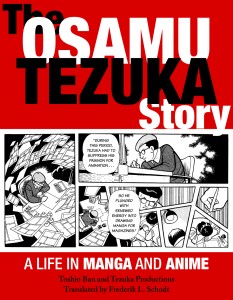
“Gargantuan in size at 928 pages (including detailed appendixes), this manga-format biography is a surprisingly quick read. Its fast-paced visuals and story provide a unique vantage to observe a legendary figure that leaves you energized after each sitting.” (Stone Bridge Press)
By Alexis Agliano Sanborn (Shimane-ken, 2009-11) for JQ magazine. Alexis is a graduate of Harvard University’s Regional Studies-East Asia (RSEA) program, and currently works as a program coordinator at the U.S.-Asia Law Institute of NYU School of Law.
For many, the newest publication from Stone Bridge Press will seem like a long lost friend. Originally serialized in 1989 and completed in 1992, The Osamu Tezuka Story: A Life in Manga and Anime, written and illustrated by Toshio Ban in association with Tezuka Productions and translated by Frederik L. Schodt, is a book worth the wait. Gargantuan in size at 928 pages (including detailed appendixes), this manga-format biography is a surprisingly quick read. Its fast-paced visuals and story provide a unique vantage to observe a legendary figure that leaves you energized after each sitting. Whether you first learned about manga and anime yesterday, five years ago, or have been a diehard fan for decades, this book has something to offer.
Manga and anime artist Osamu Tezuka carries the weight that Walt Disney carries in the West. His vision, ingenuity, and motivation defined and propelled the bourgeoning manga and anime industry of the fifties, sixties, and seventies. This book follows Tezuka through it all: from his birth in Osaka in 1928 to his death in 1989, and everything in between. Through him, we see 1930s Japan and the rise of militarism, the authoritarian interwar, the penurious postwar, and the gradual rebirth and growth leading to the booming days of the 1980s. In his lifetime, Tezuka experienced it all—feast and famine, war and peace—and it is fervently captured in his artwork and stories.
This book is written and illustrated by Toshio Ban, a longtime animator and friend of Tezuka. Carefully researched and painstakingly detailed, Ban covers everything from Tezuka’s lifelong fascination of insects, his struggle balancing his academic passion of medicine, and his artistic passion of manga and anime, to his various commutes between Takarazuka City and Tokyo. While some details are lacking (for example, the reasons behind his first animation studio Mushi Production’s bankruptcy and financial problems), Ban has created a work exhaustive as it is fascinating.
JQ Magazine: Manga Review — ‘The Birth of Kitaro’

“If you enjoy jaunts into the fun and mysterious realm of comics and mythology, don’t hesitate to pick up this affordable volume that offers a perfect introduction to a series that has captivated the imagination of generations.” (Drawn and Quarterly)
By Julio Perez Jr. (Kyoto-shi, 2011-13) for JQ magazine. A bibliophile, writer, translator, and graduate from Columbia University, Julio currently keeps the lights on by working at JTB USA while writing freelance in New York. Follow his enthusiasm for Japan, literature, and comic books on his blog and Twitter @brittlejules.
What has hair as sharp as needles, a tongue like a chameleon’s, and one empty eye socket to keep its father in? If you could only guess some kind of crazy monster…well, then you’re not far off!
Shigeru Mizuki’s Kitaro: The Birth of Kitaro is a manga volume collecting seven classic paranormal stories of the titular character from the 1960s. They include Kitaro’s origin, and yokai files with more information about his fascinating friends and enemies that endure in myth and pop culture. All are translated and written by none other than our very own Shigeru Mizuki expert (and JQ interviewee), Zack Davisson (Nara-ken, 2001-04; Osaka-shi, 2004-06).
But who is Kitaro? And what are yokai?
Kitaro is one of many yokai (basically a mysterious Japanese monster/spirit/phenomenon) that have been making waves across the world through movies, anime, video games and, of course, manga. Born from two other human-like yokai who were unable to raise him due to sickness, Kitaro was entrusted to the care of humans at a young age. Even while growing up, he could not disguise his heritage or hide from the adventures it would bring him.
Despite his child-like stature, Kitaro is a giant in the genre of yokai stories in Japan thanks to the brilliance of his creator, the legendary late artist Shigeru Mizuki. Since earlier this decade, Drawn and Quarterly has been a major force in publishing Mizuki’s works into English (nine books to date) and contributing to the boom in America of Mizuki’s work and yokai. You may already be familiar with his eerie adventures in Drawn and Quarterly’s first collection of Kitaro stories released in 2013 and translated by Jocelyn Allen. Beginning with this volume, and continuing in several more to come, more of Kitaro’s hijinks can be enjoyed in a format and price point friendly to all ages.
JQ Magazine: Book Review — ‘Monkey Business Volume 6’
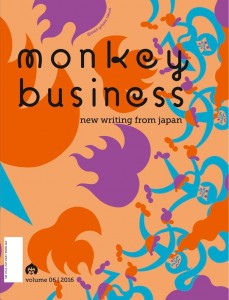
“In addition to the stories profiled here, there are other works that will make you laugh while taking you to a Japan that might not have even existed in your imagination.” (A Public Space)
By Rashaad Jorden (Yamagata-ken, 2008-10) for JQ magazine. A former head of the JETAA Philadelphia Sub-Chapter, Rashaad is a graduate of Leeds Beckett University with a master’s degree in responsible tourism management. For more on his life abroad and enthusiasm for taiko drumming, visit his blog at www.gettingpounded.wordpress.com.
Upon picking up the sixth volume of Monkey Business: New Writing from Japan, the first thought that popped into my head was that I would be introduced to epic Japanese works and/or more prominent authors from the country. After all, several award-winning writers—including Mieko Kawakami, Satoshi Kitamura and Hiroko Oyamada—produce works that appear in this volume. Quite possibly, some of the stories in this 21-piece set might become classics in Japanese literature. Or at the very least, this newbie to the Monkey Business series might discover new aspects of Japan—or be reintroduced to certain things—in rather unforgettable tales.
And well…this edition of Monkey Business doesn’t lack colorful stories. Several of them stand out, including the first one – “Forbidden Diary.” No, it doesn’t serve as an educational tour of Japanese history or culture. Instead, this excerpt of Sachiko Kishimoto’s fictional diary introduces us to a “Phantom Old Man” who has experienced Japan a little differently from the way you might have.
Let’s see…the old man (who is actually being taken care of by the narrator) remembers Shibuya as being totally void of people, as only a haven for rice paddies and without its iconic scramble crossroads. In addition to seemingly arriving out of the Stone Age, the old man repeatedly changes appearances during the story.
JQ Magazine: Book Review — ‘You Are My Best Friend’
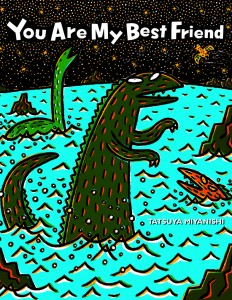
“Parents will enjoy the dinosaur’s uncanny resemblance to Godzilla and may even learn a thing or two about prehistoric creatures. Don’t worry, your kids won’t have a clue if you don’t pronounce them correctly—they’ll be too enthralled with the captivating story and dramatic images.” (Museyon)
By Heather Wilson Tomoyasu (Ibaraki-ken, 2004-06) for JQ magazine. Heather is a vlogger and blogger on her site US Japan Fam, author of “Legit Ways to Make Money from Home” (available on Kindle and iTunes), social media consultant, and mommy to twins plus one! You can follow and connect with her on Twitter, Instagram, Facebook, and Pinterest.
After a popular debut in his first children’s book, You Look Yummy, our tough but lovable friend Tyrannosaurus is back and better than ever thanks to author Tatsuya Miyanishi and his English publisher, Museyon (who also brought you 2014’s Kuma-Kuma Chan, the Little Bear). The second of a 13-book series, You Are My Best Friend features a similar transformation of the dinosaur from a violent and selfish creature to a kind and caring one, this time through the act of making a friend.
Through 26 vivid and brightly colored illustrations over 40 pages, you’ll follow Tyrannosaurus as he taunts smaller dinosaurs, finds himself ironically near death, and is then saved by another dino. This act of unexpected kindness brings about a change of heart in our tyrant, who suddenly finds himself with a best friend whom he must (spoiler alert!) in turn save at the end. The book is a heart-warming moral story that also serves up exciting twists and turns.
Parents will enjoy the dinosaur’s uncanny resemblance to Godzilla and may even learn a thing or two about prehistoric creatures. Elasmosaurus, anyone? How about Styracosaurus? No? Me, neither. Don’t worry, your kids won’t have a clue if you don’t pronounce them correctly—they’ll be too enthralled with the captivating story and dramatic images.
JQ Magazine: Book Review — ‘Japaneseness: A Guide to Values and Virtues’

“Japaneseness serves as the perfect introduction (or reintroduction) to many aspects of Japanese society you might find refreshing, fascinating or befuddling. Or at the very least, quintessentially Japanese. ” (Stone Bridge Press)
By Rashaad Jorden (Yamagata-ken, 2008-10) for JQ magazine. A former head of the JETAA Philadelphia Sub-Chapter, Rashaad is a graduate of Leeds Beckett University with a master’s degree in responsible tourism management. For more on his life abroad and enthusiasm for taiko drumming, visit his blog at www.gettingpounded.wordpress.com.
During my time in Yamagata Prefecture, I remember learning about filial piety, a virtue that the Japanese have historically cherished. I had heard about countless other values, principles and virtues that have been important in the daily lives of Japanese people. But I had totally forgotten them until…
Picking up a copy of Japaneseness: A Guide to Values and Virtues. Written by Yoji Yamakuse, Japaneseness serves as the perfect introduction (or reintroduction) to many aspects of Japanese society you might find refreshing, fascinating or befuddling. Or at the very least, quintessentially Japanese.
Yamakuse appropriately starts off the book by introducing readers to the value Japanese tend to treasure the most: harmony. Certainly, those familiar with the country recognize the importance of harmony in ensuring that a Japanese environment operates smoothly, and Yamakuse spends the first chapter explaining how related concepts (such as hospitality, thoughtfulness and modesty) contribute to maintaining harmony. That chapter—as well as the following eight (some of which are devoted to values like trust, virtue and reverence for the gods)—are further divided into sections that address other values and beliefs that are important in Japan.
JQ Magazine: ‘Jewels of Kyoto’ Brings Geisha Tradition to Australia
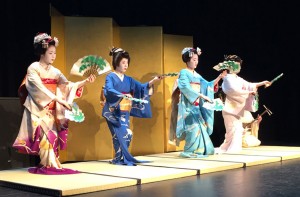
Jewels of Kyoto performed Matsu Zukushi in Sydney Feb. 23. This dance is characterized by the use of fans with a pine branch design, which represents the courage, determination and fidelity of a woman. (Eden Law)
By Eden Law (Fukushima-ken, 2010-11) for JQ magazine. Eden currently serves Country Representative for Australia and President of JETAA New South Wales.
Jewels of Kyoto was a tour of Australia and New Zealand by a group of geiko and maiko from Kyoto’s Gion district, sponsored by Japan Foundation, which ran from February 23 to March 5. Commenting for this article were Ms. Ayusa Koshi from Japan Foundation and two members of the tour group: Mr. Katsuroku-shisho of Ochaya Tomikiku, who instructs its maiko and geiko in traditional music, and Ms. Tomitae, a maiko also of Ochaya Tomikiku.
The geisha is one of the most recognisable cultural images of Japan, a symbol of the grace and beauty in Japanese traditional culture that is popular domestically and internationally. But seeing a real geisha (defined as someone who has undergone the requisite training in song, dance and social arts) is rare, and these days found only in very few places in Japan. Kyoto, of course, is best known as the place to spot geisha (or geiko, as they are known locally), and maiko (apprentice geiko) hurrying down the narrow cobbled streets of kagai (or geiko districts) in full traditional gear. As explained by Koshi, manager of Japan Foundation’s Arts and Culture Department: “Watching a geisha perform isn’t as simple as purchasing a ticket to a kabuki show. Traditionally, their artistic services were exclusive to the wealthy [who possess] the right connections, and this custom lingered until recent years.”
This is why the debut of the Jewels of Kyoto tour in Sydney was met with enthusiasm, selling out the nearly 400-seat capacity Lendlease Darling Quarter Theatre in Darling Harbour. Featuring a performance of traditional song, dance and party games (geiko are entertainers, after all) by a group of geiko and maiko, it was made possible by a collaboration between Japan Foundation and Ms. Reiko Tomimori, a prominent figure in Kyoto’s geiko world. Apart from the main stars (the geiko Hinagiku and Ryoka, and the maiko Tomitae and Tomitsuyu), there are other musicians and accompanying props and costumes.
JQ Magazine: Carnegie Hall Hosts ‘Grand Japan Theater’
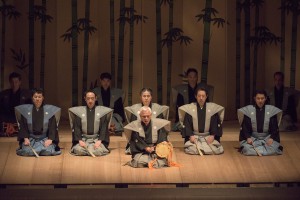
The noh portion of the evening featured Living National Treasure Kamei Tadao: “For those who attended, this was a once-in-a-lifetime experience, which fulfilled the promise of Japanese performing arts that made many of us fall in love with the culture in the first place.” (Masahito Ono)
By Vlad Baranenko (Saitama-ken, 2000-02) for JQ magazine. Vlad is an avid photographer.
On March 1, Carnegie Hall’s Stern Auditorium hosted Grand Japan Theater (also billed as An Evening of Japanese Traditional Theatre), which presented New York City with a spectacular rare performance of kyogen, noh and kabuki—all in one night. After kicking off their international tour in Tokyo and Osaka, then traveling halfway across the globe to introduce the first ever kabuki/noh performance to the royal family of Fujairah in the United Arab Emirates, the troupe finally arrived in the U.S. for one special night.
A sold-out crowd of over 2,800 witnessed some of the biggest names in traditional Japanese theater, including the noh otsuzumi artist Kamei Tadao, who in 2002 was designated as a Living National Treasure; the internationally renowned kabuki and television actor Ichikawa Ebizo XI, who began his career at just six years old and has evolved into one of the most versatile traditional actors today; and many more with direct roots to these beautiful centuries-old art forms.
The backdrop for all of the evening’s performances featured three sets of traditional Japanese screens adorned with illustrations of bamboo that blended perfectly into the background despite the enormity of the hall. The night’s program began with the kyogen piece Sanbaso. (Kyogen, an art form that almost always accompanies a noh performance and acts as a short, often comical “intermission piece” for the audience, has traditionally been based on a Shinto religious rite that prays for peace, fertility and prosperity across the land.)
JQ Magazine: Book Review — ‘The Japanese Lover’

“The Japanese Lover has its ups and downs, but it does serve as an eventful tour of various aspects of 20th century history.” (Atria Books)
By Rashaad Jorden (Yamagata-ken, 2008-10) for JQ magazine. A former head of the JETAA Philadelphia Sub-Chapter, Rashaad is a graduate of Leeds Beckett University with a master’s degree in responsible tourism management. For more on his life abroad and enthusiasm for taiko drumming, visit his blog at www.gettingpounded.wordpress.com.
We might be keeping fascinating mementos from our daily lives that if discovered, might stun many people.
Certainly, letters documenting something shocking (well, shocking during a certain period of history) would classify as that. Isabel Allende’s The Japanese Lover highlights one woman’s relationship with a Japanese national during her eventful life.
The story’s protagonist is Alma Belasco, a native of Eastern Europe was sent to live with well-to-do relatives in San Francisco when she was young. During the latter years of Alma’s life, she lives with a caretaker named Irina Bazili, who learns about an important figure who shaped Alma’s life and is described in the title of the book: a man named Ichimei Fukuda. Ichimei could also be described as a secret lover because the two had to keep their romance on the down low as it occurred during the height of World War II when people of Japanese descent were considered a threat to American society. The Japanese Lover also takes a journey not only through Alma’s life, but Irina’s as well as Ichimei’s.
JQ Magazine: Book Review — ‘Up from the Sea’
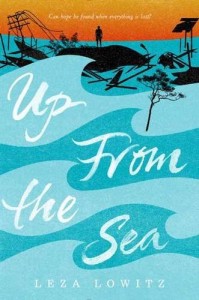
“If you’re interested in new perspectives of March 11, Up from the Sea is an easy read that might open eyes to the perseverance and strength of Tohoku’s residents.” (Crown Books for Young Readers)
By Rashaad Jorden (Yamagata-ken, 2008-10) for JQ magazine. A former head of the JETAA Philadelphia Sub-Chapter, Rashaad is a graduate of Leeds Beckett University with a master’s degree in responsible tourism management. For more on his life abroad and enthusiasm for taiko drumming, visit his blog at www.gettingpounded.wordpress.com.
The afternoon of March 11, 2011 brought unprecedented destruction along the Tohoku coast and challenges that many locals have struggled to overcome even up to this day. The survivors’ stories have been told many times since then. Now, young readers get another glimpse into that day and life in the disaster-stricken area.
Inspired by a young boy she met in the disaster zone, Leza Lowitz pieces together the events of that fateful Friday to create Up from the Sea, a fictional story (although based on the events of March 11 and its aftermath) about Kai, a teenager who uses soccer to rally his community. Up from the Sea also includes a trip Kai and others made to New York to commemorate the tenth anniversary of September 11.
Lowitz writes Up from the Sea as a verse novel instead of in prose, which makes the story a much quicker and easier read. It’s divided into three major chapters—each titled after a season of the year—that document the journey from the havoc caused by Mother Nature to an enormously successful soccer game organized in the disaster-stricken community. Kai is the narrator of the story and early on, you get the feel he is setting the stage for a documentary as he provides a brief introduction to his life and the morning of March 11— until 2:46 p.m., when Japan changes forever.
JQ Magazine: Manga Review — ‘Shigeru Mizuki’s Hitler’

“Hitler is successful at educating us about the danger posed by people who can ride the waves of pain, fear, and anger in others to bring them crashing down onto the world.” (Drawn and Quarterly)
By Julio Perez Jr. (Kyoto-shi, 2011-13) for JQ magazine. A bibliophile, writer, translator, and graduate from Columbia University, Julio currently keeps the lights on by working at JTB USA while writing freelance in New York. Follow his enthusiasm for Japan, literature, and comic books on his blog and Twitter @brittlejules.
Welcome to the most difficult book review I have ever written. Not only am I challenged to write something meaningful about a great artist’s work on a very complicated and rightfully vilified man, but I also bear a burden on my heart as I address the passing of said great artist, Shigeru Mizuki.
Last week, the world lost a much-loved cartoonist. Mizuki brought comics into the world that celebrated the strange and mysterious with unique humor and style. He brought joy to generations, young and old, with his ever popular series GeGeGe no Kitaro. He also challenged us to face and remember atrocities of war in his own country, and others, by bringing to life the war he survived through his historical manga Showa: A History of Japan, an epic work available now in English in four volumes, and a manga examination of the life of Adolf Hitler, released in English just two weeks before his passing.
We have been able to enjoy more of Mizuki’s work in the West thanks to the publishing company Drawn and Quarterly and the herculean efforts of JET Alum (and JQ interviewee) Zack Davisson (Nara-ken, 2001-04; Osaka-shi, 2004-06), who translated all four parts of Showa as well as Hitler. Davisson, a great fan of Mizuki, maintains a blog on Japanese tales, monsters, and yokai, where you can find his own work and more about the legendary cartoonist.
Justin’s Japan: ‘You Look Yummy!’
By JQ magazine editor Justin Tedaldi (CIR Kobe-shi, 2001-02) for Shukan NY Seikatsu. Visit his Examiner.com Japanese culture page here for related stories.
For parents of little ones not quite ready for Jurassic World comes You Look Yummy!, a children’s book by Tatsuya Miyanishi and newly published in English by Museyon.
The story of a fearsome Tyrannosaurus (the star of 11 other bestselling titles written by the author) and the baby Ankylosaurus he grows attached to (the tot believes his “daddy” names him “Yummy” after he’s hatched), You Look Yummy!, teaches valuable lessons about the bonds between a parent and child, and how those bonds can remain strong despite mistaken identity.
As “father” and “son” grow close, the Ankylosaurus mimics the T-Rex in ramming mountains, cutting down trees and roaring (complete with his own muted sound effects). When the day comes for them to part, readers will be touched by what unfolds.
Children will be instantly attracted to Miyanishi’s illustrations. Throughout its pages, there are artistic touches like a white sky, coloring outside the edges to make the images pop, and hash marks for the dinos that serve as texture 101. Especially effective are scenes of a night sky jam-packed with stars and dotted with some exaggeratedly large ones (think Christmas tree). The result is something that feels like it could have been drawn by a child, but is secretly the work of a seasoned artist—after all, the Tyrannosaurus is a dead ringer for Godzilla.
For more information, visit www.museyon.com.
JQ Magazine: Manga Review — ‘Showa 1953-1989: A History of Japan’

“Shigeru Mizuki has led a full life of hardship and wonder. At the time of this book’s publication, he is 93 and still bringing laughter to many through his enormous body of award-winning work, which is thankfully becoming more available in English.” (Drawn and Quarterly)
By Julio Perez Jr. (Kyoto-shi, 2011-13) for JQ magazine. A bibliophile, writer, translator, and graduate from Columbia University, Julio currently keeps the lights on by working at JTB USA while writing freelance in New York. Follow his enthusiasm for Japan, literature, and comic books on his blog and Twitter @brittlejules.
Showa 1953-1989: A History of Japan is the fourth and final volume of the English translation of Shigeru Mizuki’s manga history of the Showa period. Translated for the first time into English by JET alum (and JQ interviewee) Zack Davisson (Nara-ken, 2001-04; Osaka-shi, 2004-06), the release of this book marks the end of a long journey for us readers. Mizuki took great pains to detail significant events of the Showa period and Japan’s role in World War II in order to preserve a comprehensive look at the time from the perspective of someone who had lived it. He intended this manga history to be a gift for all the generations born in a time of peace. As a reader born in the first year of the Heisei period, I was not even alive for any single event I read about, but nevertheless was moved by the power of Mizuki’s personal and historical storytelling and art to think about world history in new ways. The best part of reading something by Mizuki is you’re in for plenty of laughs along the way as well.
As a refresher for those of you who have been with us from the start, and an intro for those just tuning in, the first volume of this illustrated history of the Showa period in Japan covered the years 1926-1939 and highlighted a modernizing Japan and Mizuki as a child fascinated by spirits called yokai, and almost as importantly, a child obsessed with food. The book chronicled a number of incidents in Japan and Asia that took Japan down the road to World War II that come to a head in the second book which featured the years 1939-1944. This volume devotes itself to capturing the massive scale and harrowing death tolls of air-, sea-, and land-based conflicts in the war, and as time passes Mizuki’s own autobiographical narrative weaves in as he serves in the army. The third volume covers 1944-1953 and sees the darkest parts of Japanese history in World War II, and Mizuki’s own experiences are spotlighted, but it is not without the hope and admiration for humanity inspired from Mizuki’s encounter with the natives of Rabaul. This book also covers the Allied occupation of Japan and the beginning of what historians call “Postwar Japan” in which Mizuki starts down the path that will lead him to manga success and Japan becomes a booming economic power.
Interestingly, the last volume covers 1953-1989, which is 36 years of history and among the other volumes is the one that tackles the longest period of time. It’s also the most varied in its content. The same historical approach to events from a variety of perspectives narrated by either Nezumi Otoko or Mizuki himself persists through this volume, but as TV, movies, and popular culture take on an increasingly larger significance in society, so do strange events take on a more significant coloring in history. Mizuki devotes many pages to portraying abnormal events both comical and criminal that preoccupy the public mind by way of showing how times have changed since before the war. For this reason, the fourth volume at times can sometimes feel like a series of short historical episodes told in manga form, but of course presented in a chronological and unified way.
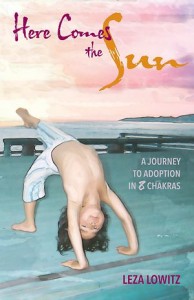
“Here Comes the Sun conveys how with persistence, perseverance and patience, seemingly impossible hurdles in Japan can be overcome.” (Stone Bridge Press)
By Rashaad Jorden (Yamagata-ken, 2008-10) for JQ magazine. A former head of the JETAA Philadelphia Sub-Chapter, Rashaad is a graduate of Leeds Beckett University with a master’s degree in responsible tourism management. For more on his life abroad and enthusiasm for taiko drumming, visit his blog at www.gettingpounded.wordpress.com.
“Sometimes, you have to travel a very great distance to find a home within yourself.”
That saying could certainly describe the journey of Leza Lowitz, a Californian who has worked extensively in Japan. She chronicles her path through several eventful periods—such as adolescence during the tumultuous early 1970s, her romance with a Japanese man named Shogo (whom she eventually weds), and her attempts to adopt in Japan in Here Comes the Sun: A Journey to Adoption in 8 Chakras, an autobiographical story that captures the ups and downs of Lowitz’s efforts to carve a niche in Japanese society.
As indicated by the subtitle of the book, Lowitz utilizes the influence of another culture to best integrate herself into Japanese society. But first, you might be asking… what’s a chakra? Derived from the Sanskrit root car (“to move”), a chakra represents a major wheel of energy in the human body, and each chakra contains a particular function. Chakras regulate, distribute and balance the energy and nerve functions of their locations.
Lowitz calls the chapters in Here Comes the Sun “chakras” and each one contains a certain theme. For example, the first chapter in the book is titled Muladhara, derived from the Sanskrit word for “root” or “support.” Some chapters in Here Comes the Sun deal directly with the yoga practices that balance a chakra—Lowitz tells us when the aforementioned primary chakra is balanced, you’ll feel stable and secure while being in a better position to succeed.

